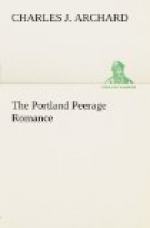The Duke’s estates in Scotland include Langwell Lodge, which the family has frequently visited for deer-stalking and grouse-shooting in the autumn. Then there is Cessnock Castle, near Galston, Ayrshire, where the Duke and Duchess had not stayed for many years till 1906. A considerable part of the fifth Duke’s Ayrshire estates, including the Kilmarnock property, passed at his death to his sister, Lady Ossington, and at her death to another sister, Lady Howard de Walden, and thence to Lord Howard de Walden. The Duke has extensive shootings at Fullarton, near Troon, and Fullarton House was for some time the residence of Louis Philippe of France.
The house of Langwell is situated on a beautiful grassy slope, with the sea in front, while in the background are the silver-clad Scarabines, rising with imposing grandeur. The Langdale and Berriedale rivers here join and flow into the sea, and there are picturesque gorges, with cave-dwellings and ancient ruins having historic associations. Frowning cliffs rise precipitously from the waves, and weird caves, only to be entered when the tide is low, add to the romantic character of the scenery.
In the neighbourhood of this favourite shooting lodge are some steep and dangerous hills which presented great difficulties to the horses when taking his Grace’s guests to and fro to enjoy their sport. But having become a votary of the motorcar, these stiff hills have been surmounted with ease by the four or five vehicles which the Duke has acquired for sporting purposes. Helmsdale is the nearest railway station to Langwell, and the road over the Ord of Caithness includes several hills with rough and loose surfaces, and gradients ranging from 1 in 2 to 1 in 16, so that the journey is not without its stress both for horses and motorcars. John o’ Groat’s is forty-five miles distant, but this, as well as other places of interest in the neighbourhood, is within visiting range by the cars, though such long distances were not attempted with the equine species.
To capture the Master of the Horse as an automobilist was a great achievement for enthusiasts in the advocacy of the new mode of travelling. The Duke of Portland has been such a devotee to the horse, as were his ancestors centuries before him, that it was not to be expected all at once, that he would, give his countenance to any new invention likely to supplant the noble animal in its position as the servant and friend of man. Having been a cyclist, when that hobby seized the fancy of the fashionable world, it was not a long step to automobilism, and having proved the superiority of the motor vehicle, the Duke gave orders for some of the best types of cars to be supplied to him. One of the most luxurious is a Limousine de Deitrich, and his interest in the new art of locomotion is such that he has had a perfect track prepared at Clipstone, called “The flying kilometre.”
In 1907 the Duke became a member of the Royal Automobile Club and submitted all his drivers for examination for the certificate. The test took place at Welbeck, when there were shown several technical drawings executed by the candidates, who all passed with merit and received their certificates.




